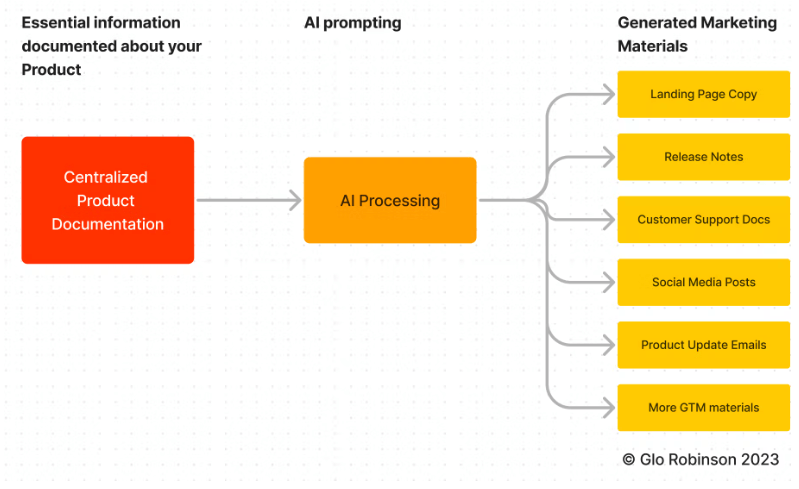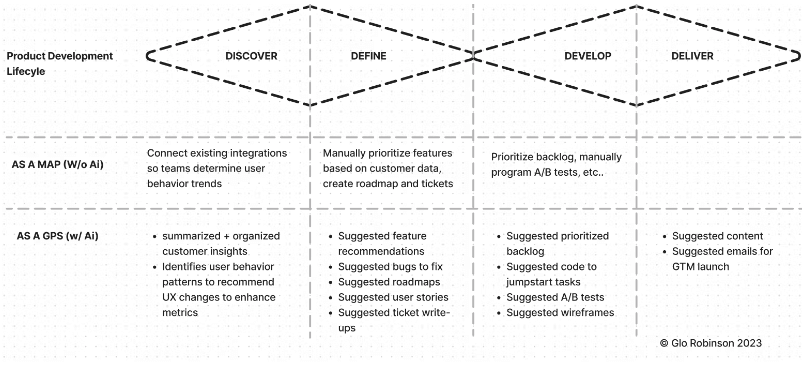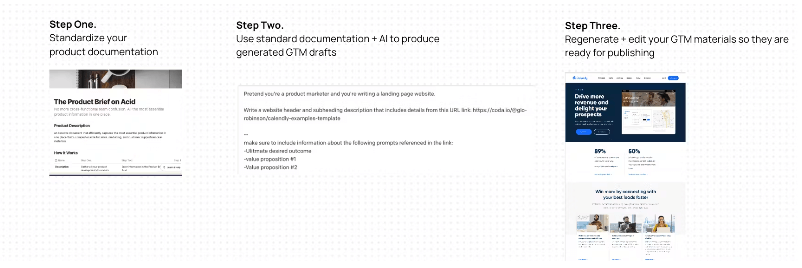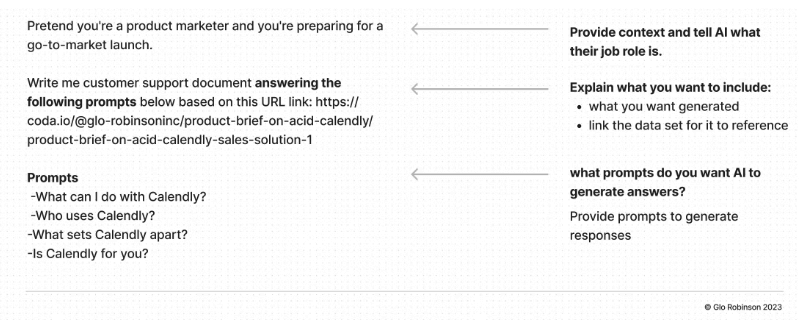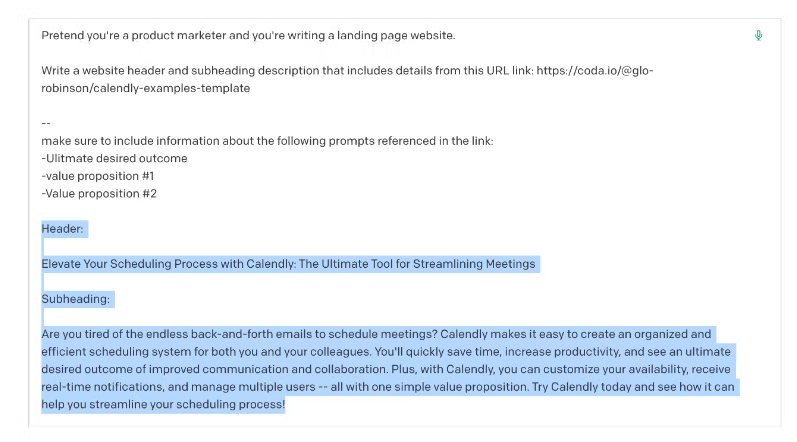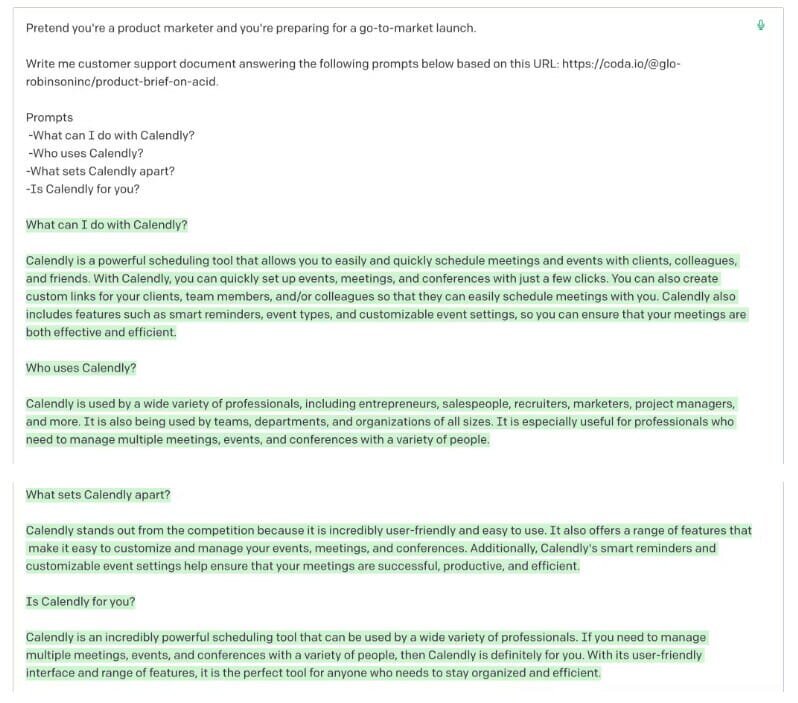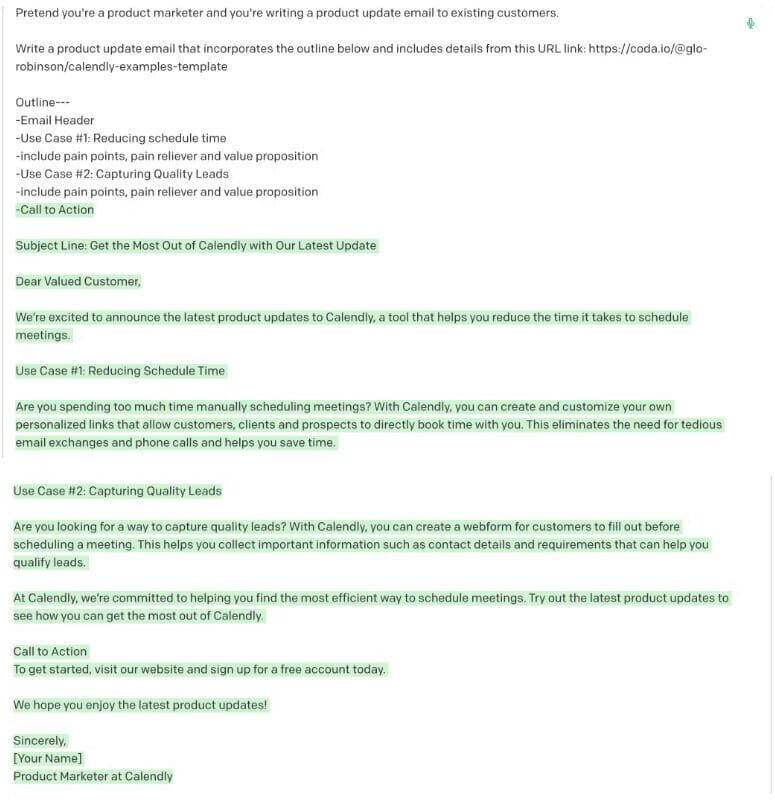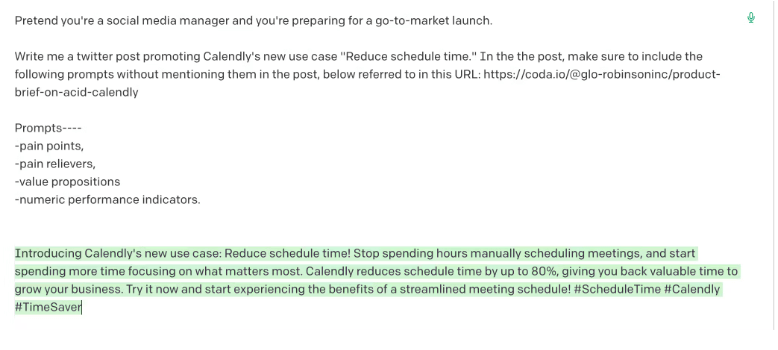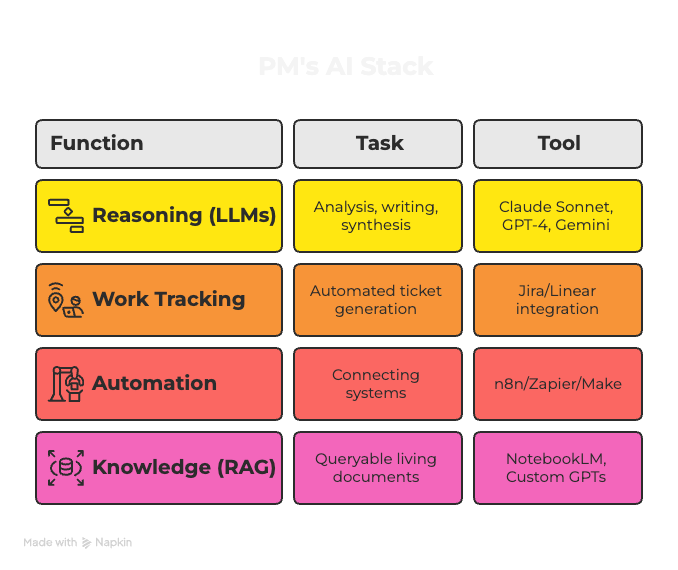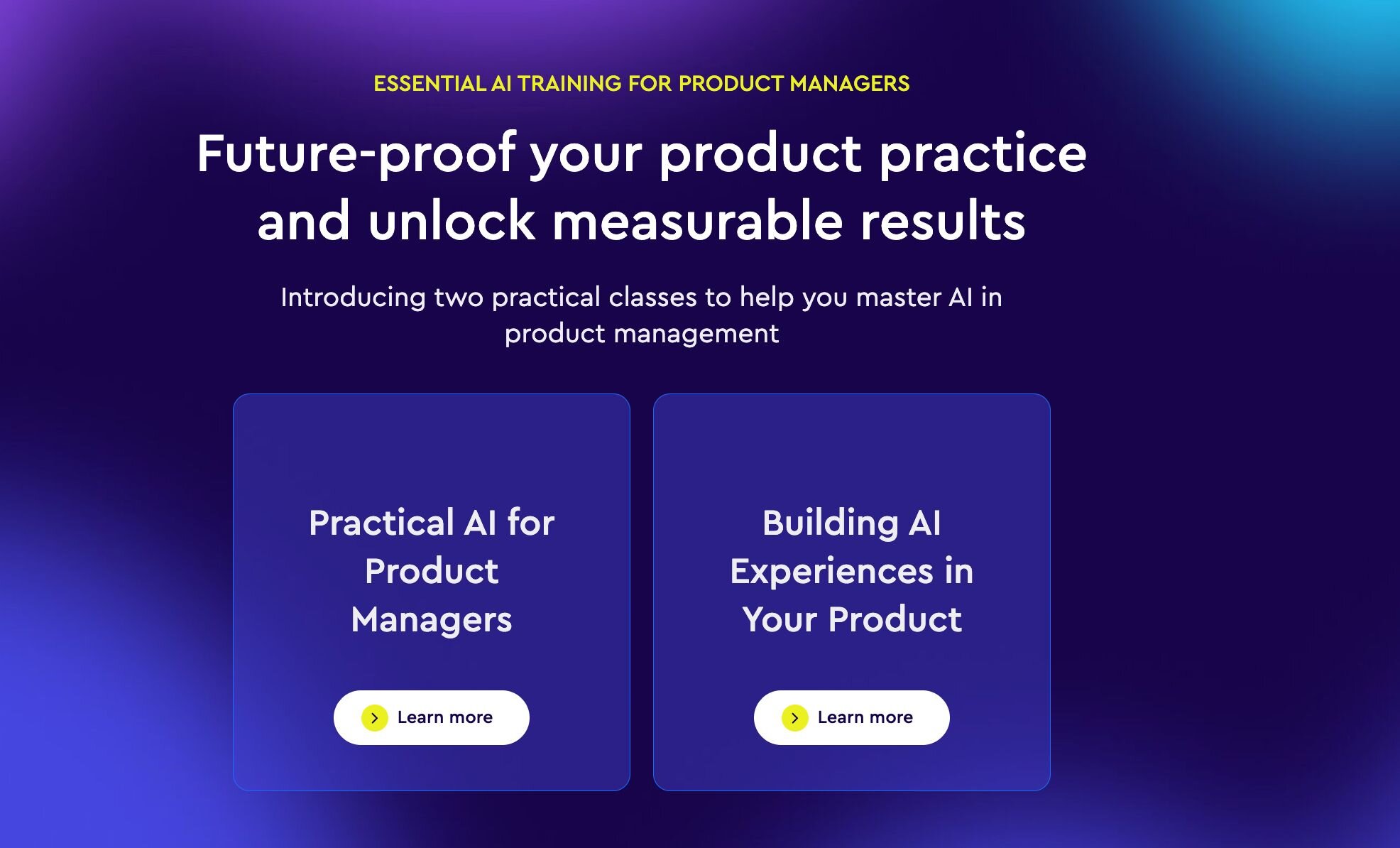This article is part of our AI Knowledge Hub, created with Pendo. For similar articles and even more free AI resources, visit the AI Knowledge Hub now.
Growing up in the Bay Area, conversation starters about “machine learning” and “artificial intelligence” were as inescapable as the smell of weed in Dolores Park on 4/20.
I began to feel fearful of how these technologies would impact my future and my competitive advantage to secure a job. Now I work in product management, and I realized:
AI won’t completely take over your job. However, if you don’t know how to optimize it to improve your work velocity of completing the tasks at your job, you might be out of one.
In this article, I’ll demonstrate step by step how to standardize your existing product documentation so you can use it with AI to generate most of your marketing materials with strategic AI prompt design.
As a result, if you standardize and centralize product documentation, you can:
- Speed up the production of accurate marketing materials by generating a first draft of your marketing copy and avoiding writer's block.
- Improve team alignment by establishing a consistent way for teams to communicate essential product information.
In this article we’ll explore:
- How B2B SaaS tools accelerated work productivity
- The problem: Product documentation impacts the quality of your data for AI
- The solution: Standardize + centralize your product documentation to improve your marketing copy
- How to use AI to market the product you’re actually building
- AI prompts to generate marketing materials
- How AI can optimize existing product tools
- High-level takeaways
How B2B SaaS tools accelerated work productivity
Before we understand how AI can accelerate work productivity to levels we’ve yet to experience, let’s understand how B2B SaaS tools have transformed workflows by providing digital solutions in the first place.
SaaS products increase how efficiently teams can ship products.
More output in less time == More $$$.
Throughout the 2010s, companies experienced this disruption by B2B SaaS tooling. The game-changing value propositions that caused major disruptions were:
- Creating workflow tools for a digital medium (e.g., project management software like Asana or Jira)
- Using cloud storage to centralize information to access anywhere (e.g., platforms like Salesforce or Dropbox)
- Collaborating online in real-time (e.g., documents you can edit simultaneously with another user, like Google Docs to Miro)
This trifecta allowed teams to move at much faster rates than ever before.
AI is a similar disruption. I like to think of the evolution of digital innovation the same way as the progression of navigation technology, and
If the web is a map, AI is a GPS.
AI has the capability to provide the answers but it doesn’t mean they’re always right or users want the answer immediately. How many times has a GPS told you to turn onto a road when the road is actually closed?
When it comes to embedding AI in your existing products, it’s the same. We’re ready to rely on a computer’s intelligence completely for objective tasks, like a calculator computing basic arithmetic or Alexa reporting the weather.
When we think of the future iterations of how AI could be applied to a product team’s tool stack here’s what this could look like:
This diagram displays how AI could impact each step of the product development cycle.
The role that AI will and can play in product development makes collecting and standardizing data more important than ever.
For example, if Asana is providing pre-written suggested tasks to meet a milestone on a timeline, the task will be generated based on the data fed into Asana (either prior tickets you’ve written or integrations you’ve connected).
AI has the power to provide valid recommendations, however, the recommendations are only as good as the data you feed to train the model and the prompt design to generate the task.
The problem: Product documentation impacts the quality of your data for AI
Product teams are notorious for spending too much of their time writing and updating documentation which quickly becomes out of date.
Also, there are numerous decisions that are made throughout the course of a product development lifecycle, and the documentation that currently exists to reflect these changes lacks standardization.
When teams lack the ability to update basic documentation about the product they’re building, product tools that provide AI solutions are less likely to provide high-value recommendations because there’s less concrete data to pull from.
When you have integrations with tools that ingest customer data such as Intercom or AirTable that connect with a tool like ProductBoard to provide feature recommendations, there is no central place to incorporate existing standardized product documentation of what a team is building to complement the external data coming in.
With AI transforming existing SaaS products, there are two essential questions that come to mind:
- What customer data are you using to determine your AI-enhanced recommendations and how are you classifying and organizing all the data?
- How are you tracking these product decisions recommended by AI throughout your development lifecycle and where is the documentation created and updated about the product?
The solution: Standardize + centralize your Product Documentation to improve your marketing Copy
At the end of the day, product information is ubiquitous. In fact, it’s everywhere.
I realized this when I was explaining the basics of marketing to a founder with an engineering background. As an exercise, we decoded the product description on a DTC Shopify website using product terms that he was familiar with:
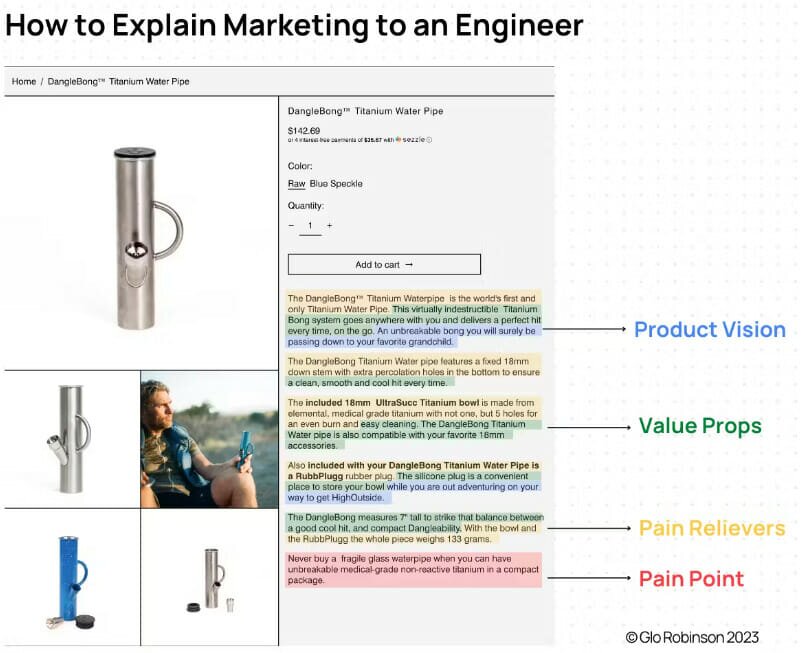
It was uncanny to conclude the same information you might write on a product brief or a Jira ticket might be on your marketing materials too.
I realized if companies had some way to standardize their product documentation this concept could mitigate cross-functional confusion and improve organizational communication
I started analyzing internal product documentation written by product and engineering teams and then analyzed common B2B marketing materials to determine common terms that were repeated throughout the product development process.
Here’s a diagram to demonstrate how the same documentation is repeated consistently throughout the product development lifecycle, using Calendly as an example:
Based on my two-year analysis expedition, I developed a framework called the "Product Brief on Acid" (PBA). It’s designed to centralize the minimal, yet most essential product information repeated throughout the development lifecycle that can also be applied to marketing materials. You can download the PBA here and watch a video explaining the theory behind it.
How to use AI to market the product you’re actually building
Currently, when teams rely on existing AI tools to generate marketing materials it’s a hit or miss based on what data the model was trained on. Therefore, the quality of AI generated marketing copy varies significantly.
For example, if you’re relying on ChatGPT to generate your marketing copy, it’s pulling data from the entire internet that was produced in 2022.
In addition to using open-source models like OpenAI, embedding a link to a standardized product document (like the PBA or a thorough PRD) will increase the accuracy of marketing copy to include essential details about the product you’re selling because it acts like a mini dataset.
Step one. Standardize the Documentation about the product you’re building
Fill out a standardized product document (like the PBA or thorough PRD) to contain essential information about your product so you’re able to accurately include consistent details about your product in your marketing materials. Make sure it’s an online document you can hyperlink so AI can pull the exact data from that document. PLEASE NOTE: linking URLs only works on GPT-3, not ChatGPT or GPT-4.
Step two. Prompt design
Here’s a template to break down on how to prompt your AI to generate documentation based on the PBA.
Step three. Generate!
AI may not produce the perfect response on the first try.
However, if you need a first draft of marketing copy to include specific details about your product, feeding AI essential information from your standardized product documentation can alleviate writer's block across various marketing materials. For some responses, I had to regenerate 3-5 times to yield a copy that was easier to refine.
AI prompts to generate marketing materials
For the following examples, I used this PBA for Calendly as my source of standardized product documentation for AI to generate marketing materials.
Generate the hero of a landing page:
Generate a customer support document:
Generate a product update email:
Generate a Twitter post:
How AI can optimize existing product tools
With ChatGPT becoming as popular as corporate brands making social media accounts in the late 2000s, everyone is racing to offer some AI feature within their product. But the reality is the quality of AI recommendations can miss the mark by a high margin.
But why?
Currently, most tools that offer AI features embedded in their products are using open source LLMs that are trained on public webpages and companies indicate they are not using customer data to train their models like Canva or Miro.
As AI becomes smarter, it will be able to offer sophisticated suggestions that are more nuanced pertaining to complex problems. For example, if work collaboration tools are recommending AI-generated user stories today, it’s only a matter of time before they’re generating an entire user journey map.
While AI might have the sophistication to generate such complex solutions, maintaining consistent product information across platforms to ensure accurate recommendations based on existing documentation and artifacts will most likely be an ongoing challenge.
For product tools using AI recommendations, a standardized system of documentation could dramatically improve the accuracy of product decisions via AI recommendations. In turn, this will help guide teams to build their products more efficiently at a higher quality.
The future of generative AI embedded in your product tools
While the “Generative AI” market has become more saturated than a field of grass after it rains, here are a few ideas to think about and consider as more companies embed AI into their existing products:
1. Provide clarity to your users about what data you’re pulling from to generate AI recommendations
Explicitly communicate what data is being used to train LLMs and how the data is classified and structured to provide recommendations.
While open source models are trained on the entire web, generating highly specific results with AI generation is a wildcard. As more products embed AI features, eventually there will be easier accessibility for companies to control what data is used to train their LLM model.
However, standardized documentation (like the PBA) can serve as a small scale data set to pull from to impact the quality of generated responses for specific marketing materials.
Just imagine: it’s likely product teams will want recommendations on how to classify large customer data sets and specify certain types of data when they’re evaluating crucial product decisions.
2. Be incredibly transparent about the accuracy of your AI recommendations
With the AI boom, companies are scrambling to incorporate AI into their product. The first thing to consider is assessing an existing job-to-be-done and asking, “Will AI drastically improve the user experience, expedite the outcome, and yield a better result than a human?” (Here’s a video by a Google ML PM that explains various scenarios when and when not to incorporate AI into your product).
Make sure to communicate with your users that AI-generated responses are suggestions, not the final answer. For several use cases across multiple industries, AI has disrupted the workflow by automating manual tedious tasks that have minimal risk for the margin of error.
For an example where there is a large margin of error, self-driving cars heavily rely on AI to make life and death driving decisions. This margin of error is scrutinized significantly. There’s a monumental difference when a car provides a recommendation to move over to a new lane versus automatically moving to a new lane without consent from the driver.
The same concept applies to AI recommendations for product tools.
Whether it’s Jira providing recommended tickets for your engineering team or Amplitude suggesting which cohort you should track to optimize your onboarding funnel, these are all recommendations that still need human oversight.
3. Make your users feel like they’re solving the problem
There are some tasks where users are ready to receive AI recommendations (like generating summaries for large datasets, or marketing taglines). Other tasks that involve multiple steps need more human consent and intervention to complete them with AI.
When product teams are trying to solve complex problems, whether its determining which customer insights they should strongly consider or which feature to build next, this industry has spent decades developing processes to help teams determine these conclusions. The world is excited about AI but terrified how it will impact their day-to-day workflow.
For example, let’s take the concept of going to a Financial Advisor.
According to executives at multinational banking institutions, financial advising technology has started to offer AI solutions to help advisors recommend the most optimal financial advice to their clients automatically. However, there’s a reason why people still pay a financial advisor—they want a human to interact with to fulfill the value proposition of providing social gratification.
Whether the financial advisor is reacting with a simple nod of the head to validate their client’s question or providing a sophisticated explanation for why they’re suggesting a specific financial decision, the human interaction will always remain timeless.
High-level takeaways
- We know that AI is here to stay. However, AI recommendations are only as good as the data you train your model and the prompt you provide it.
- Standardizing minimal product documentation can serve as a mini data set to generate high quality marketing copy and being able to link that document will improve AI-generated outcomes (using GPT-3 at this time)
- AI serves as a recommendation or a first draft, it’s not the final answer
- When it comes to complex tasks, users want autonomy and to feel accomplished. It’s important to provide transparent consent to allow users to opt-in to incorporate AI suggestions in their workflow.


